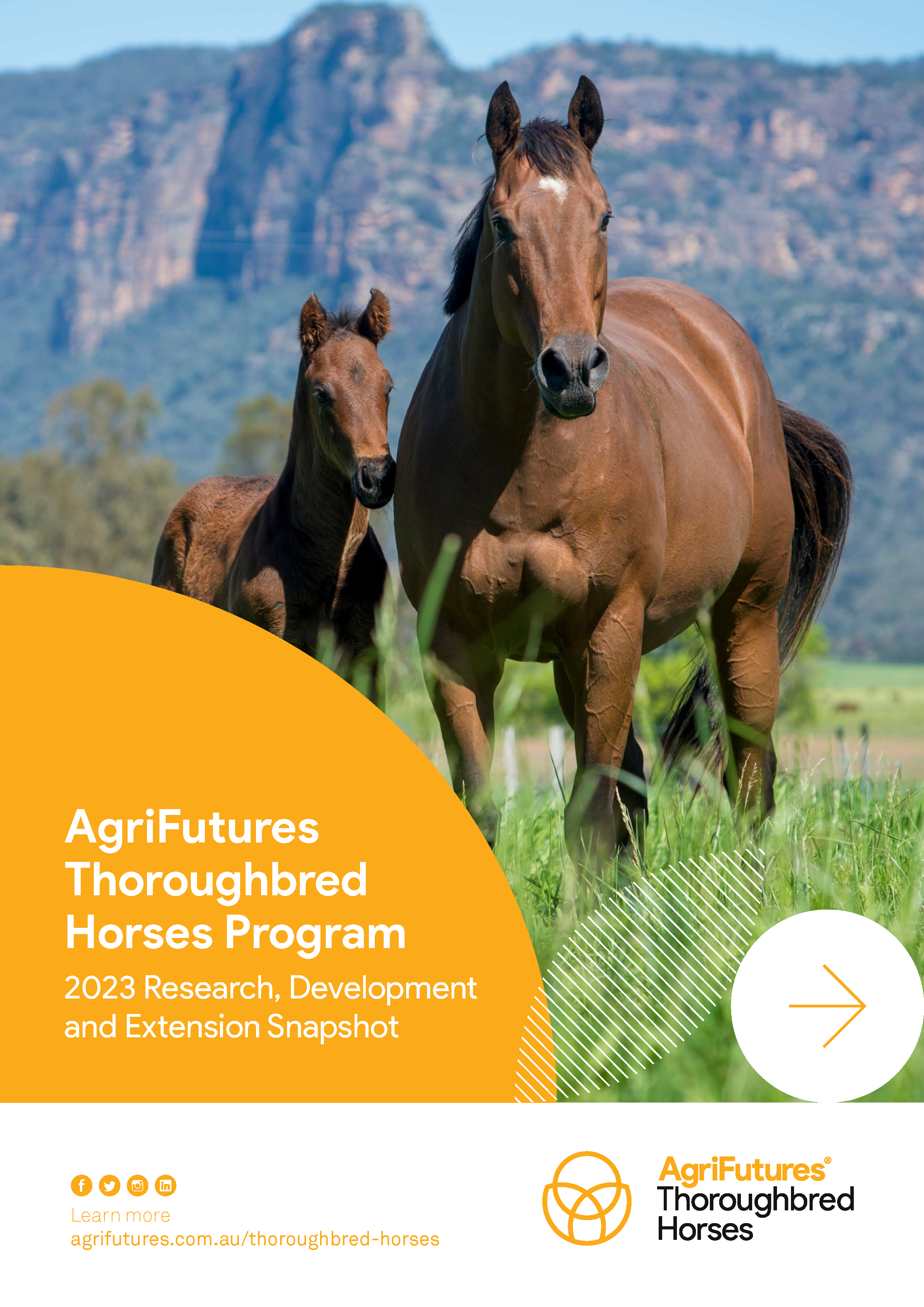Fact sheet: Equine herpes virus
Equine herpes virus (EHV) is a DNA virus found in horses all around the world. There are different strains of EHV, with the most common...
 THOROUGHBRED HORSES
THOROUGHBRED HORSES 
92 pages
Published: 20 Jun 2023
Author(s): AgriFutures Australia
ISBN: 978-1-76053-342-7
Download report PDF
DownloadPurchase a hard copy - AUD $60
Welcome to the annual AgriFutures Thoroughbred Horses Program RD&E Snapshot, my first as Chair of the Advisory Panel.
As this RD&E Snapshot goes into the final stages of production, we are busily assessing responses to our latest open call for high-impact research into horse welfare and breeding, and to better understand the Australian thoroughbred industry’s economic value. The Australian breeding industry is the second-largest in the world, with more than 650 stud farms located across the country. The industry is responsible for generating in excess of $1.16 billion for the Australian economy. The racing industry contributes even more, injecting over $9.15 billion per annum.
The AgriFutures Thoroughbred Horses Program’s new five-year strategic plan for research and associated call for high-impact projects will ensure the industry continues to contribute socially and economically to Australia into the future. As we enter the second five-year strategic period following the introduction of the thoroughbred levy in 2017, I have been reflecting on how far we have come since the Program’s establishment. I am awe-inspired by the progress made across our key priority areas.
In particular, we are making clear headway into the puzzle that is equine fertility and reproduction. From the stallion’s side of the stall, we are on the brink of being able to offer thoroughbred breeders a simple and rapid device to test fertility on farm. This is the first device of its kind that delivers high-quality, biologically meaningful science on farm without the need for specialist expertise or prohibitively expensive equipment.
We are gaining insights into the impact of heat stress and ageing on stallion fertility, and have tangible management advice for thoroughbred breeders, to ensure they optimise the fertility of their stallions through the crucial breeding season. On the mare side, our investigations into the risks associated with pregnancy through a two-phase post-mortem project is yielding ground-breaking outcomes. Each year, approximately 12,000 thoroughbred foals are born across Australia. Despite this figure, more than 5% of mares abort their pregnancies each season, resulting in financial loss to the mare owner and, in some cases, a health and safety risk to horses and humans.
During the first half of this project, pathologists reviewed more than 450 sets of laboratory reports and post-mortem material, and produced detailed visual atlases of the features of equine pregnancy loss. For the second year in a row, we have clinics across the eastern seaboard offering free confidential post-mortems for thoroughbred breeders to enable greater insight into the causes of equine pregnancy loss, allowing them to reduce the risk of avoidable foal deaths. I encourage our breeders to grasp this opportunity firmly with both hands. The more we know about the causes of early pregnancy loss, the better able we will be to prevent it.
Despite these exciting developments, there is always more work to be done. Among the many challenges our industry faces, the issue of internal parasite resistance to common drenches is starting to rear its ugly head. The results of more than four years of research indicate resistance in intestinal worms is rife across all major thoroughbred breeding regions. Perhaps more concerning is the resistance to change within the industry. About 60% of thoroughbred breeders surveyed as part of that project control worms in their horses using an ‘interval-based’ deworming approach. According to project lead, Prof. Abdul Jabbar, less than 30% of breeders surveyed assess the efficacy of a dewormer used on their properties with a faecal egg count reduction test (FECRT).
During the coming months, we are looking to industry to guide the way forward. I encourage you to engage with us to determine the next steps in addressing this growing challenge. Prof. Jabbar’s research has given us a clear picture of what is happening on the ground with regards to worm resistance, but we know worms are just one part of a much larger, complex landscape for thoroughbred breeders. We want to understand where worms fit within breeders’ overall management program and priorities, and how we can best target our next phase of research to support practical and effective control strategies.
Dr Catherine Chicken
Chair, AgriFutures Thoroughbred Horses Advisory Panel